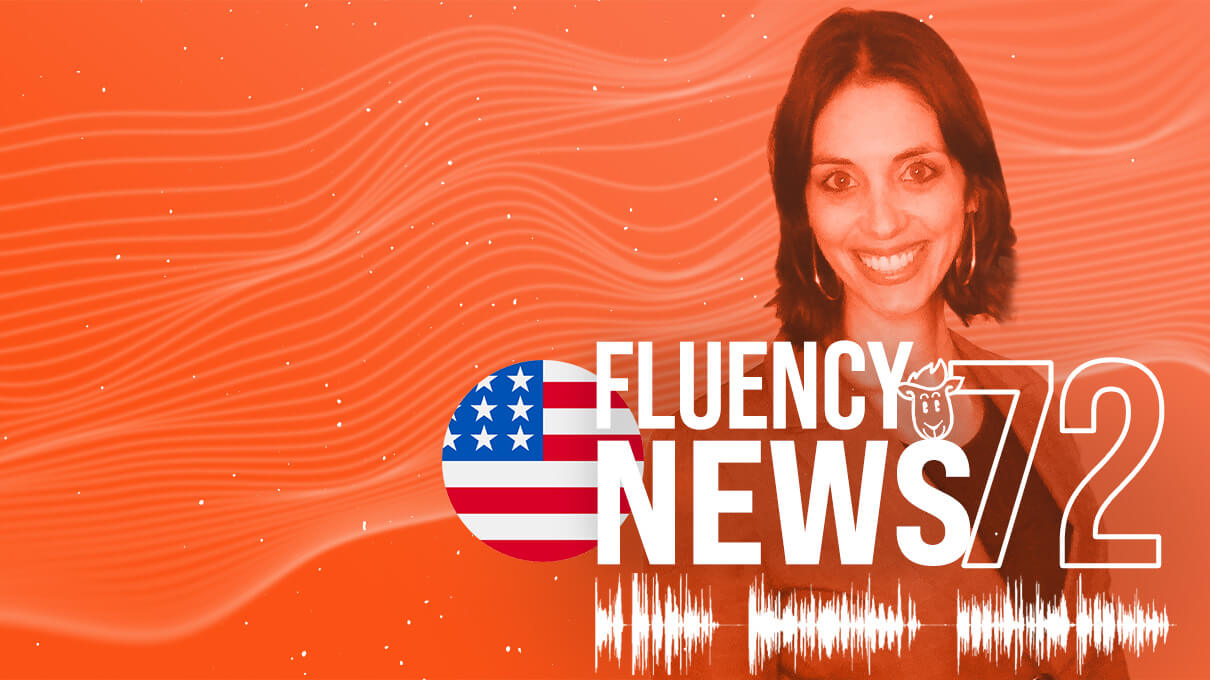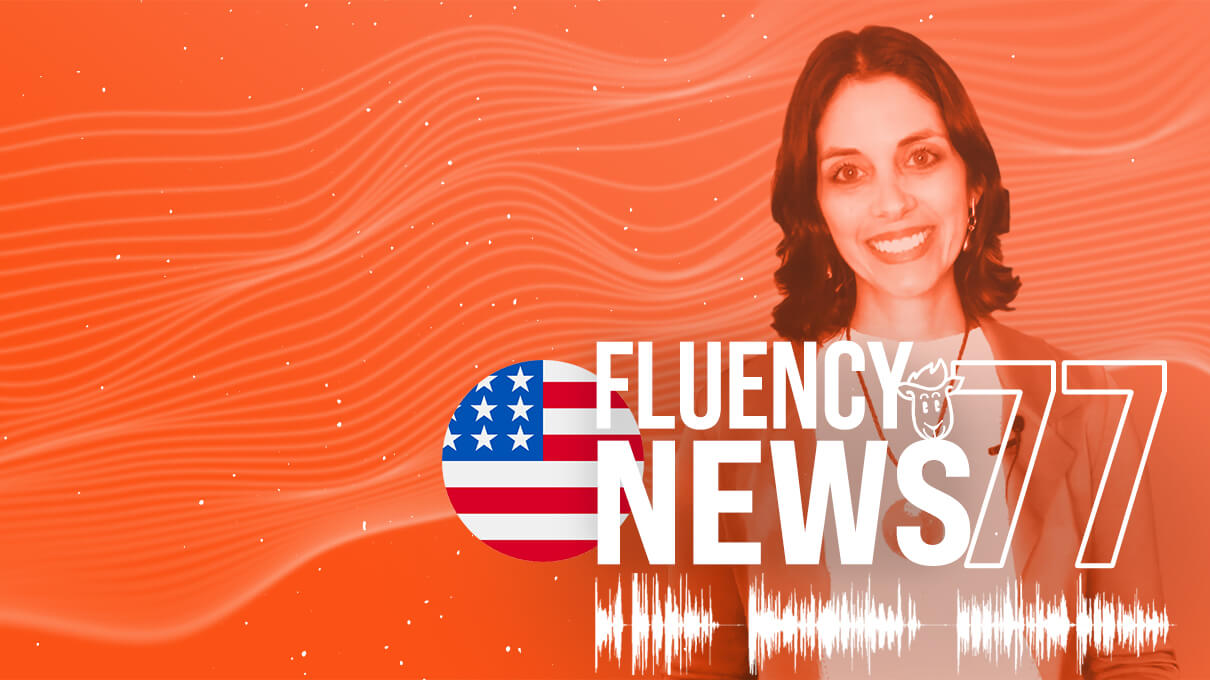Fluency News #08

Hello, everyone!
Sejam bem-vindos e bem-vindas a mais um episódio da nossa nova série de podcasts, o Fluency News! Aqui, você vai treinar a sua escuta e ficar por dentro do que está acontecendo no mundo, sempre com as três principais notícias da semana, tudo em inglês! Ao longo do episódio, nós também adicionamos explicações em português das coisas que achamos que precisam de mais atenção, assim você não perde nenhum detalhe!
Neste episódio, nós falamos sobre o relatório do New York Times sobre os impostos pagos por Trump, os ciberataques direcionados ao maior sistema de saúde dos Estados Unidos, a possibilidade de se encontrar água em Marte e, por fim, sobre a terapia celular que está sendo desenvolvida para tratar a síndrome do intestino irritável.
Nós temos uma nova página de dicas de inglês no Instagram, vá conferir! @fluencytvingles
Toda semana temos um novo episódio do Fluency News, não deixe de conferir! See you!
TRANSCRIPT
What is up, everyone! Welcome back to Fluency News, your news podcast from Fluency Academy. I’m Scott Lowe and I’m super excited you’re here with me. Today more than usual. Have you heard? Fluency Week 3 is happening as we speak!
What do you mean, you don’t know what that is? Well, let me tell you! Fluency Week is the biggest free language learning event in the world. It’s a week to study languages, yes, languages, plural. You can choose to study English, Spanish, Italian, French or German, or even more than one language. The event is happening from September 27th to October 4th, which means you still have time to check it out.
There are over 20 lessons for you to watch, secret lives, downloadable material, and many other surprises. Head over to fluencyweek.com.br to learn more. We’ll also leave the link in the description, in case you’re listening to us through a streaming platform.
Alright, what do you say we get started? Today’s first story is around the New York Times’s report around the US president.
President Donald Trump paid just $750 in federal income taxes the year he ran for president and in his first year in the White House, according to a report Sunday in The New York Times. Trump, who has fiercely guarded his tax filings and is the only president in modern times not to make them public, paid no federal income taxes in 10 of the past 15 years. The details of the tax filings complicate Trump’s description of himself as a shrewd and patriotic businessman, revealing instead a series of financial losses and income from abroad that could come into conflict with his responsibilities as president. The president’s financial disclosures indicated he earned at least $434.9 million in 2018, but the tax filings reported a $47.4 million loss.
The tax filings also illustrate how a reputed billionaire could pay little to nothing in taxes, while someone in the middle class could pay substantially more than him. Roughly half of Americans pay no income taxes, primarily because of how low their incomes are. But IRS figures indicate that the average tax filer paid roughly $12,200 in 2017, about 16 times more than what the president paid. The disclosure, which the Times said comes from the tax return data it obtained extending over two decades, comes at a pivotal moment ahead of the first presidential debate Tuesday and weeks before a divisive election against Democrat Joe Biden.
Speaking at a news conference Sunday at the White House, Trump dismissed the report as “fake news” and maintained he has paid taxes, though he gave no specifics. He also vowed that information about his taxes “will all be revealed,” but he offered no timeline for the disclosure and made similar promises during the 2016 campaign on which he never followed through. In fact, the president has fielded court challenges against those seeking access to his returns, including the U.S. House, which is suing to get Trump’s tax returns as part of congressional oversight.
During his first two years as president, Trump received $73 million from foreign operations, which in addition to his golf properties in Scotland and Ireland included $3 million from the Philippines, $2.3 million from India and $1 million from Turkey, among other nations. The president in 2017 paid $145,400 in taxes in India and $156,824 in the Philippines, compared to just $750 in U.S. income taxes. The Times said the tax records did not reveal any unreported connections to Russia. Trump found multiple ways to reduce his tax bills. He has taken tax deductions on personal expenses such as housing, aircraft and $70,000 to style his hair while he filmed “The Apprentice.” Sorry to break this to you, Dony, but you got ripped off by that hairstylist. Losses in the property businesses solely owned and managed by Trump appear to have offset income from his stake in “The Apprentice” and other entities with multiple owners.
During the first two years of his presidency, Trump relied on business tax credits to reduce his tax obligations. The Times said $9.7 million worth of business investment credits that were submitted after Trump requested an extension to file his taxes allowed him to offset his obligations and pay just $750 each in 2016 and 2017. Income tax payments help finance the military and domestic programs. Trump, starting in 2010, claimed and received an income tax refund that totaled $72.9 million, which the Times said was at the core of an ongoing audit by the IRS. The Times said a ruling against Trump could cost him $100 million or more.
The president could also face mounting financial pressure in the years ahead. The tax records show he’s carrying a total of $421 million in loans and debt that are primarily due within the next four years. Most of that debt comes from the Doral golf resort in Florida ($125 million) and Trump’s Washington hotel ($160 million), two properties that the Times said are struggling financially.
“It appears that the President has gamed the tax code to his advantage and used legal fights to delay or avoid paying what he owes,” Neal wrote in a statement. “Now, Donald Trump is the boss of the agency he considers the adversary. It is essential that the IRS’s presidential audit program remain free of interference.”
A lawyer for the Trump Organization, Alan Garten, and a spokesperson for the Trump Organization did not immediately respond to a request for comment from The Associated Press on the report. Garten told the Times that “most, if not all, of the facts appear to be inaccurate.” He said in a statement to the news organization that the president “has paid tens of millions of dollars in personal taxes to the federal government, including paying millions in personal taxes since announcing his candidacy in 2015.” The New York Times said it declined to provide Garten with the tax filings in order to protect its sources, but it said its sources had legal access to the records.
During his first general election debate against Democrat Hillary Clinton in 2016, Clinton said that perhaps Trump wasn’t releasing his tax returns because he had paid nothing in federal taxes. Trump interrupted her to say, “That what makes me smart.”
Essa notícia tem um monte de valores e números altos. Você já deve ter percebido que usamos os termos “thousand” quando falamos sobre os valores em milhares, “million” para quando falamos sobre os valores em milhões e “billion” para quando falamos sobre os valores em bilhões. Repare que não usamos essas palavras no plural, mesmo quando dizemos um valor como “$160 million”. Mas, é claro, podemos usar essas palavras no plural se usamos elas isoladamente, como na frase “paying millions”, ou na expressão “tens of millions of dollars”, que quer dizer algumas “dezenas de milhões de dólares”. Lembre-se que se dizemos um valor como “434.9 million”, queremos dizer 434 milhões e 900 mil, pois a palavra “point” (ponto) em inglês é usada com a mesma função que a vírgula em português para separar as casas decimais dos números.
Wow, how about that, huh? No comment. Now we move to our second story of the day, still talking about my home country, the US.A major hospital chain has been hit by what appears to be one of the largest medical cyberattacks in United States history.
Computer systems for Universal Health Services, which has more than 400 locations, primarily in the U.S., began to fail over the weekend, and some hospitals have had to resort to filing patient information with pen and paper, according to multiple people familiar with the situation. Oh my God, no! Not pen and paper!
Universal Health Services did not immediately respond to requests for comment, but posted a statement to its website that its company-wide network “is currently offline, due to an IT security issue”. One person familiar with the company’s response efforts who was not authorized to speak to the press said that the attack “looks and smells like ransomware.” Ransomware is a type of malicious software that spreads across computer networks, encrypting files and demanding payment for a key to decrypt them. It’s become a common tactic for hackers, though attacks of this scale against medical facilities aren’t common. A patient died after a ransomware attack against a German hospital in early September required her to be moved to a different hospital, leading to speculation that it may be the first known death from ransomware.
Hackers seeking to deploy ransomware often wait until the weekend, when a company is likely to not have as many technical staff members present. Two Universal Health Services nurses, who requested to not be named because they weren’t authorized by the company to speak with the media, said that the attack began over the weekend and had left medical staff to work with pen and paper. One of the nurses, who works in a facility in North Dakota, said that computers slowed down and then eventually simply would not turn on in the early hours of Sunday morning.
“As of this a.m., all the computers are down completely,” the nurse said. Another registered nurse at a facility in Arizona who worked this weekend said “the computer just started shutting down on its own.” “Our medication system is all online, so that’s been difficult,” the Arizona nurse said.
While many patient charts at that facility are on paper, medical information is maintained online, though it’s backed up at the end of each day, the nurse said. “We had those up to date as of the 26th,” the person said. “Now we had to hand-label every medication,” the nurse said. “It’s all improv.” Ransomware can devastate hospitals. In 2017, a ransomware strain called WannaCry, created by hackers working for the North Korean government, spread across the world and infected the U.K.’s National Health System even though it wasn’t a direct target. The attack disrupted at least 80 medical facilities, though there were no publicly reported deaths associated with the incident.
Kenneth White, a computer security engineer with more than a decade of experience working with hospital networks, said that the delays caused by ransomware attacks can have dire consequences for patients. “When nurses and physicians can’t access labs, radiology or cardiology reports, that can dramatically slow down treatment, and in extreme cases, force re-routing for critical care to other treatment centers,” he said. “When these systems go down, there is the very real possibility that people can die.
Uma palavra que aparece muito em notícias é o THOUGH, que pode ser traduzido por palavras diferentes no português, como: mas, embora, ainda que, ou apesar. Ele é muito usado para dar esta ideia de contraste, de oposição de ideias. É legal reparar que ele é bem versátil, porque pode aparecer em vários lugares das frases: no começo, no meio e até no final das frases. Nesta notícias, temos a frase “though it’s backed up at the end of each day”, que tem justamente o sentido de “ainda que”. Outro uso comum é do o EVEN THOUGH, que dá mais ênfase ao sentido THOUGH, como na frase “ even though it wasn’t a direct target”.
Ok, now we go a bit further. We’re getting out of the US and going into space!
The existence of liquid water on Mars — one of the more hotly debated matters about our cold, red neighbor — is looking increasingly likely. New research published Monday in the journal Nature Astronomy indicates that there really is a buried reservoir of super salty water near the south pole. Scientists say such a lake would significantly improve the likelihood that Mars might just harbor microscopic life of its own.
Oh, aliens! Some scientists remain unconvinced that what’s been seen is liquid water, but the latest study adds weight to a tentative 2018 finding from radar maps of the planet’s crust made by the Mars Express robot orbiter. That research suggested that an underground “lake” of liquid water had pooled beneath frozen layers of sediment near the south pole — akin to the subglacial lakes detected beneath the Antarctic and Greenland ice sheets on Earth. Earth’s subglacial lakes are teeming with bacterial life, and similar life might survive in liquid reservoirs on Mars, scientists have speculated.
“We are much more confident now,” said Elena Pettinelli, a professor of geophysics at Roma Tre University in Italy, who led the latest research and the earlier study. “We did many more observations, and we processed the data completely differently.” Pettinelli and her team processed 134 observations of the region near the south pole with ground-penetrating radar from the Mars Express orbiter from 2012 to 2019, more than four times as many as before, and covering a period of time more than twice as long.
They then applied a new technique to the observation data that has been used to find lakes beneath the Antarctic ice sheet, as well as an older technique used in the 2018 study. Both methods indicate that there is a “patchwork” of buried reservoirs of liquid in the region, Pettinelli said — a large reservoir about 15 miles (24,14 km) across, surrounded by several smaller patches up to 6 miles (9,65 km) across. The researchers can’t tell how deep the reservoirs go, but they begin about a mile below the surface, she said. And while the radar doesn’t show what they’re made of, they are probably “hypersaline” solutions — water saturated with perchlorate salts of calcium, magnesium, sodium and potassium — that keep them liquid at minus 90 degrees Fahrenheit (- 67 degrees Celsius) and below, Pettinelli said.
The new study of a potential underground niche for life on Mars comes just a few weeks after scientists reported finding potential signs of life in the clouds of Venus. If there really are buried bodies of liquid water, they might be a prime spot where microbial alien life could survive on Mars, perhaps a remnant of the life that might have existed there billions of years ago if Mars had seas of water on its surface. Liquid water is a key ingredient for life as we know it, although exotic chemistries for life based on hydrocarbons or carbon dioxide have also been proposed. Mars is now thought to be bone dry, but moisture in its atmosphere freezes during Martian winters as water ice above the permanent carbon dioxide ice caps at the north and south poles. If the discovery is verified, it would be the first time liquid water has been found on Mars, and it would have a profound impact on the search for extraterrestrial life.
Steve Clifford of the Planetary Science Institute, a nonprofit based in Tucson, Arizona, said he agrees that an underground body of water is the most plausible explanation for the radar observations by the Mars Express, but he argued that it might not be as cold or as salty as the researchers suggest. Clifford, who worked on the Mars Express mission but wasn’t involved in the new study, said he thinks the underground liquid could be created by heat from the planet’s hot interior melting the icy sediments in the same way that geothermal heat melts the base of the Antarctic ice sheet in some regions. This would mean that the underground reservoirs on Mars needn’t be extremely salty to stay liquid, he said.
Not everyone is convinced by the new study, however. Planetary scientist Jack Holt of the University of Arizona’s Lunar and Planetary Laboratory in Tucson said in an email that Mars was probably much too cold for even hypersaline water to exist as a liquid and that if it did, then liquid water would also exist in regions that looked the same in the radar maps. “If we apply the same interpretation, then there should be springs flowing out along the edge of the polar cap,” he said. “And that is not the case.” Holt works with radar on the Mars Reconnaissance Orbiter, which has seen no signs of liquid water. The Mars Express researchers suggest that it is using the wrong radar wavelengths to see them. Holt also said any description of buried “lakes” of water is misleading: “At best, patchy wet sediment,” he said. “But even that is a stretch.”
Se você acompanha o Fluency News, você já conhece os Modal Verbs, que são verbos especiais em inglês que mudam o sentido de outros verbos, certo? Bem, um exemplo de Modal Verb é o MIGHT, que usamos para falar de possibilidades ou especulações. Nessa notícia, usamos uma estrutura com o MIGHT chamada Perfect Modal, que é basicamente quando juntamos um Modal Verb com a estrutura do Present Perfect, ou seja, do HAVE + um verbo no Particípio Passado. Mas, calma que é mais simples do que parece! A frase sobre a qual estou falando é “the life that might have existed there billions of years ago”. Nessa frase, usamos o MIGHT HAVE EXISTED para especular sobre um evento passado, algo que possivelmente aconteceu, mas que não temos certeza absoluta. Você pode usar essa estrutura com outros Modal Verbs, como o WOULD ou SHOULD e falar sobre coisas que teriam ou deveriam ter acontecido no passado, mas que não aconteceram ou que não temos como ter certeza de que aconteceram.
And finally! How about we see some good news? Medicine keeps advancing and the UPV/EHU’s NanoBioCel research group is developing systems that enable cells to be used as drugs. Cell therapy raises hopes for treating those diseases for which there are as yet no effective pharmacological solutions. Biomaterials, a journal in the field of materials sciences and medicine, has just published the paper “Multifunctional biomimetic hydrogel systems to boost the immunomodulatory potential of mesenchymal stromal cells,” which reports on the results of one of the lines of research of this group at the UPV/EHU’s Faculty of Pharmacy. Hey, if you don’t what any of those medical terms mean, well, neither do I. The results obtained so far are very encouraging, and the researchers hope to make headway in a multifunctional cell therapy system to treat inflammatory bowel disease. They have already commenced studies on ulcerative colitis in animal models.
“Perhaps the best known side is the use of stem cells in regenerative therapies,” said Rosa Hernández, professor of the Faculty of Pharmacy and researcher at CIBER-BBN, “We have all heard, for example, about the use of chondrocytes in cartilage regeneration or cardiomyocytes to repair a heart following myocardial infarction. However, our research group is working on evaluating the therapeutic action of stem cells by means of their paracrine effects, in other words, mediated by a set of growth factors and cytokines released by the cells.”
In a whole host of disorders with an inflammatory component, such as ulcerative colitis or Crohn’s disease, a possible beneficial effect following delivery of stem cells has been seen. On the basis of this, this group of researchers, led by Dr. Rosa Hernández and Dr. Manoli Igartua, embarked on a project three years ago to develop systems designed to address the problems arising in clinical trials conducted with these stem cells. Even though the potential of stem cells to treat these inflammatory disorders became clear in these trials, problems, such as the rapid elimination of cells from the body, the possible development of tumors or their reduced capability in releasing therapeutic substances were also detected, so new technological solutions had to be sought.
This group of UPV/EHU researchers, whose leading members are Ainhoa Gonzalez-Pujana and Dr. Edorta Santos-Vizcaíno, successfully designed and tested a multifunctional system recently in collaboration with Harvard University in Cambridge (U.S.), specifically with the group led by Dr. David J. Mooney. “Besides stem cells, the system incorporates other elements, such as biomaterials and microparticles that release interferon. That way, the activation of the cells can be prolonged so that they constantly release key cytokines and growth factors to treat these disorders; in addition, the persistence of the cells in the body and the biosafety of the therapy can be improved,” said Dr. Hernández.
Bom, nessa notícia, temos vários termos específicos da ciência e da medicina. Vamos explorar melhor alguns deles? Falamos muito sobre “cell therapy” que é a terapia celular (também chamada citoterapia) que é uma forma de terapia na qual material celular é injetado num paciente para auxiliar em um tratamento específico. Para isso, podem ser usadas “stem cells”, as células-tronco, que enviam sinais a outras células, o que chamamos de “paracrine effects”, para que se regenerem. Também foram mencionados nomes de doenças ou problemas do corpo, como “inflammatory bowel disease”, a doença inflamatória intestinal, e o “myocardial infarction”, que é o infarto do miocárdio, ou como dizemos comumente, o “infarto do coração”. Mas a boa notícia é que as pesquisas têm mostrado avanços no combate a essas “disorders”, doenças, com as “stem cells”.
And that’s it for today! I hope you had fun here with me. Don’t forget you have access to the transcript of this episode and all the sources by going to fluency.io. Go check out Fluency Week, if you haven’t already. It’s the perfect opportunity to study English or Italian, or Spanish, or German, or French. But the event is almost over, so hurry up. If you’re listening to this AFTER the event has ended, don’t worry! Going to fluency.io you have access to over 600, yes, 600 free classes! What are you waiting for? Head to fluency.io to enjoy all that free stuff!
There’s a new episode of Fluency News every week, and I’ll be waiting for you. Peace out.
Sources:
NY Times: Trump paid $750 in US income taxes in 2016, 2017: https://apnews.com/article/archive-personal-taxes-donald-trump-f0e2af5f9f99de9d30dc6b9097121188
Cyberattack hits major U.S. hospital system: https://www.nbcnews.com/tech/security/cyberattack-hits-major-u-s-hospital-system-n1241254?cid=sm_npd_ms_tw_ma
Liquid water on Mars? New research indicates buried ‘lakes’: https://www.nbcnews.com/science/space/liquid-water-mars-new-research-indicates-buried-lakes-n1241234
Cell therapy designed to treat inflammatory bowel disease: https://medicalxpress.com/news/2020-09-cell-therapy-inflammatory-bowel-disease.html
Fluency Inglês
Playlist







































































































 Curso de Inglês
Curso de Inglês
 Curso de Espanhol
Curso de Espanhol
 Curso de Francês
Curso de Francês
 Curso de Mandarim
Curso de Mandarim
 Curso de Italiano
Curso de Italiano
 Curso de Japonês
Curso de Japonês
 Curso de Alemão
Curso de Alemão
 Curso de Coreano
Curso de Coreano








 Blog
Blog  Podcast
Podcast  Lives
Lives  Aulas
Aulas  eBooks
eBooks  Minicursos
Minicursos














